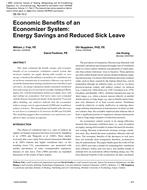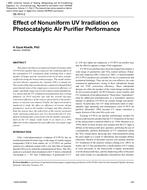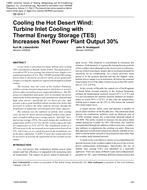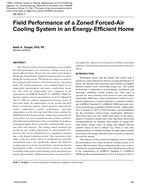-
-
Available Formats
- Options
- Availability
- Priced From ( in USD )
-
Available Formats
-
- Immediate download
-
$16.00Members pay $7.00
- Add to Cart
Customers Who Bought This Also Bought
-

DE-05-08-3 - An Owner’s Perspective on Commissioning of C...
Priced From $16.00 -

DE-05-10-2 - Economic Benefits of an Economizer System: E...
Priced From $16.00 -

DE-05-05-2 - Effect of Nonuniform UV Irradiation on Photo...
Priced From $16.00 -

DE-05-06-1 - Cooling the Hot Desert Wind: Turbine Inlet C...
Priced From $16.00
About This Item
Full Description
The objective of the current investigation was to evaluate the field performance of a forced-air cooling system in an energy-efficient home. The test site was a three-story home in Pittsburgh, Pennsylvania, and field measurements were made during the cooling season. The forced-air system was zoned by floor and operated in both a zoned mode and in a non-zoned mode. The system performance was evaluated based on air temperature measurements and space conditioning energy use. The room air temperatures were compared to the requirements of ASHRAE Standard 55 (ASHRAE 2004b) for thermal comfort and recommendations of ACCA Manual D (ACCA 1995) for uniform temperatures between rooms. In non-zoned mode, the temperatures on the second and third floors exceeded the setpoint. Zoned operation improved the system temperature control performance, providing temperatures on the first and third floors that satisfied the ASHRAE and ACCA requirements. Temperature control for the second floor was not acceptable because of three problems: false thermostat temperatures due to air leakage, heat gain to uninsulated supply ducts in partially conditioned attic space, and solar load diversity. The zoning control increased the energy use per cooling degree-hour by approximately 6%; however, this was not considered to be a significant variation due to the limited evaluation period. One conclusion of the study is that heat gain to ducts in conditioned (or partially conditioned) space can significantly impact the delivered cooling capacity to rooms. A preliminary conclusion from the investigation is that a zoned forced-air system can provide acceptable temperature control during cooling operation in an energy-efficient home. Additional research is recommended to investigate the impact of correcting the problems associated with Zone 2 (thermostat temperature issue and ducts in the attic space).
Units: Dual





